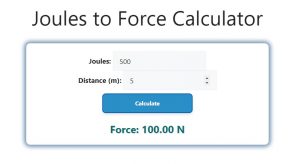About Joules to Force Calculator (Formula)
The Joules to Force Calculator is a handy tool used to convert energy (in joules) into force (in newtons). This is essential in physics and engineering, where understanding the relationship between energy and the force applied over a specific distance is critical. By using the formula, you can quickly determine how much force is generated when a specific amount of energy is applied over a given distance.
Formula
The formula to convert joules to force is as follows:
Force (N) = Joules (J) / Distance (m)
Where:
- Force (N) is the force in newtons,
- Joules (J) is the energy in joules, and
- Distance (m) is the distance over which the energy is applied in meters.
How to Use
- Determine Energy in Joules: Gather the amount of energy in joules that you wish to convert into force.
- Measure the Distance: Measure or estimate the distance over which the energy will be applied in meters.
- Apply the Formula: Divide the energy in joules by the distance in meters to calculate the force in newtons.
- Interpret the Result: The result will give you the force applied over the given distance.
Example
Let’s say you want to calculate the force when 500 joules of energy is applied over a distance of 5 meters.
Using the formula:
Force (N) = 500 J / 5 m
Force (N) = 100 N
In this case, 100 newtons of force is applied when 500 joules of energy is exerted over 5 meters.

FAQs
- What is a Joules to Force Calculator?
A Joules to Force Calculator is a tool that helps convert energy measured in joules into force measured in newtons, given the distance over which the energy is applied. - How do I calculate force from joules?
To calculate force from joules, divide the total energy (in joules) by the distance (in meters) over which the energy is applied. - What units are used in a Joules to Force calculation?
The units used are joules (J) for energy, meters (m) for distance, and newtons (N) for force. - Can this formula be used for any type of force?
Yes, this formula applies to any situation where energy is applied over a distance to calculate the resulting force. - What is a joule in simple terms?
A joule is a unit of energy. It represents the amount of energy transferred when applying a force of one newton over a distance of one meter. - What is a newton in simple terms?
A newton is the unit of force in the International System of Units (SI). It is the force required to accelerate a mass of one kilogram by one meter per second squared. - Why is distance important in the formula?
Distance is important because it defines how far the energy is applied. The longer the distance, the less force is exerted for the same amount of energy. - Can I use this calculator for any type of energy conversion?
This calculator is specifically for converting energy (in joules) into force, given the distance. It’s best suited for physical scenarios where force is applied over a distance. - What happens if the distance is zero?
If the distance is zero, no force is applied, as force cannot be generated if there is no distance over which the energy can be exerted. - Can the Joules to Force formula be rearranged?
Yes, if you know the force and distance, you can rearrange the formula to calculate energy in joules. The formula becomes: Joules (J) = Force (N) × Distance (m). - What if I have the distance but not the energy?
You can’t use the Joules to Force Calculator without knowing the energy. Both energy and distance are required to calculate force. - How does this calculator differ from other force calculators?
This calculator specifically calculates force using energy and distance. Other force calculators may use different parameters like mass and acceleration. - How do joules relate to other units of energy?
One joule is equivalent to one watt-second or one newton-meter. It is the standard unit of energy in the International System of Units (SI). - Can this calculation be used for both horizontal and vertical distances?
Yes, as long as you have the correct measurements for distance, the formula can be applied to both horizontal and vertical scenarios. - Does this calculation take into account friction or resistance?
No, this formula does not account for external factors like friction or resistance, which could affect the actual force applied. - Is there a limit to the amount of energy that can be calculated?
There is no theoretical limit to the amount of energy that can be used in the calculation, though practical limits may arise depending on the scenario. - How accurate is the Joules to Force Calculator?
The accuracy depends on the precision of the values inputted for energy and distance. Ensure accurate measurements for the best results. - Can I use this formula for real-world applications?
Yes, the Joules to Force formula is used in various real-world applications, including engineering, physics, and mechanics. - What industries benefit from using the Joules to Force Calculator?
Industries such as automotive, aerospace, and mechanical engineering often use this calculation to understand energy transfer and force application. - How can I apply the result of this calculation in practice?
Once you calculate the force, you can use it to design systems or machines where energy and force are critical, such as engines, motors, and structural components.
Conclusion
The Joules to Force Calculator is an essential tool for converting energy into force based on the distance over which it is applied. By using the formula and understanding how it works, you can accurately calculate the force generated in various physical systems. Whether you’re working in engineering or studying physics, this calculator simplifies the process of determining how energy is translated into force.